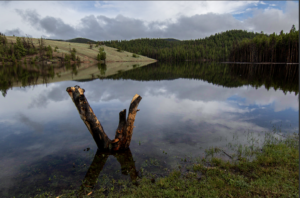
FORT COLLINS, Colo. – The annual forest health report, released today by the Colorado State Forest Service, details how ongoing warm temperatures and below-average precipitation create challenges for Colorado’s forests. Even though monsoonal rains came in 2022 to parts of Colorado, relieving some of the drought, it will take several years of adequate precipitation for trees to recover their natural defenses to bark beetle attacks. And these forest pests continue to expand into new areas with vulnerable, drought-stressed trees.
Large swaths of forests affected by forest pests and diseases increase the potential for large, uncharacteristic wildfire, so living with wildfire and watershed protection are top priorities for forest management across the state. Additionally, having sufficient tree seedlings to reforest areas affected by wildfire and floods is another top concern for the future of Colorado.
“Challenges persist for Colorado’s forests,” said Matt McCombs, state forester and director of the CSFS. “This report highlights how ongoing drought, an indicator of a warming climate, continues to stress our forests, setting the stage for insect and disease outbreaks and large, destructive wildfires. We know people continue to move into wildfire-prone areas as Colorado’s population grows and more homes are built in the wildland-urban interface. These challenges are enormous, but the state is on the right path to bringing about fundamental changes in the landscape that protect water quality, reduce fuels and sustain our outdoor recreation economy.”
Through collaborative, cross-boundary forest management, grants, and education and outreach, the CSFS addresses these multiple challenges. Healthy trees and forests are fundamental to the Colorado way of life, and this report acknowledges the stressors on forests and the myriad actions taken to protect our forested landscapes.

2022 Key Forest Takeaways
The 2022 Report on the Health of Colorado’s Forests focuses on three top priorities for the CSFS and its partners for forest management in Colorado:
- Insects and Diseases: Aerial survey data show Colorado has a new top bark beetle: the western balsam bark beetle affected more acres last year statewide than spruce beetle, which had held that title for a decade. Scientists from the CSFS and the U.S. Forest Service flew over 29.9 million acres of forests to spot insect damage and followed up with observations on the ground. Throughout the state, bark beetles and other pests continue to move into areas of Colorado’s forests with drought-stressed trees susceptible to attack.
- Living with Wildfire: The number and intensity of wildfires in Colorado in 2022 was less than in previous years, but communities and homeowners must continue to take steps to reduce their risk of loss from wildfire. Community Wildfire Protection Plans are an important way for people to work together to prepare for wildfire, and the CSFS updated the guidelines for these in 2022. Funding from the legislature in 2022 will support a wildfire awareness campaign in 2023 that will target individual homeowners with tips on how they can reduce risk to their homes and properties.
- Watershed Protection: Colorado is a headwaters state, and residents of Colorado and 18 other states rely on water from our forested watersheds. Reducing the risk to infrastructure and water quality from uncharacteristic wildfire is critically important, and the CSFS leads projects with partners across the state to safeguard this precious resource.

Regional Forest Health Issues
- Northeast Colorado: Long-term drought conditions continue to influence forest health in this part of the state. Foresters are monitoring a potential outbreak of mountain pine beetle in the Interstate 70 corridor near Black Hawk, and western spruce budworm is active in Jefferson and Park counties, affecting Douglas-fir, true fir and spruce trees.
- Southeast Colorado: Dense forests and ongoing drought allow the spread of piñon Ips beetles; outbreaks can kill wide swaths of trees, altering the composition of piñon-juniper and ponderosa pine forests. Severe winds in April and May 2022 caused about 1,260 acres of windthrow in different areas, leaving downed trees vulnerable to bark beetles.
- Southwest Colorado: Spruce beetle, mountain pine beetle, roundheaded pine beetle and western spruce budworm are the major causes of forest mortality in this region of Colorado.
- Northwest Colorado: The risk of uncharacteristic wildfire remains high in this area due to the mountain pine beetle epidemic in the early to mid-2000s that left forests thick with dead trees, resulting in a large amount of fuel. Also, high-elevation forests in this area are losing stands of subalpine fir trees to a combination of the western balsam bark beetle and fungi that cause root decay.
Each year, the forest health report provides information to the Colorado General Assembly and residents of Colorado about the health and condition of forests across the state. Information for the report comes from an annual aerial forest health survey by the CSFS and USFS, Rocky Mountain Region, as well as field inspections, CSFS contacts with forest landowners and special surveys.
For the first time, the report is exclusively online. Read the report and explore interactive maps of insect and disease activity.

